National Geographic photographer Tim Laman, renowned for his global wildlife photography and popular books Birds of Paradise: Revealing the World’s Most Extraordinary Birds and Bird Planet, was invited to judge the 2024 National Geographic Taiwan Photo Contest. Despite his busy schedule, he took time from his globe-trotting schedule to visit Taiwan as an award presenter and shared his decades of experience and stunning images in a photography forum centered on a world of birds.
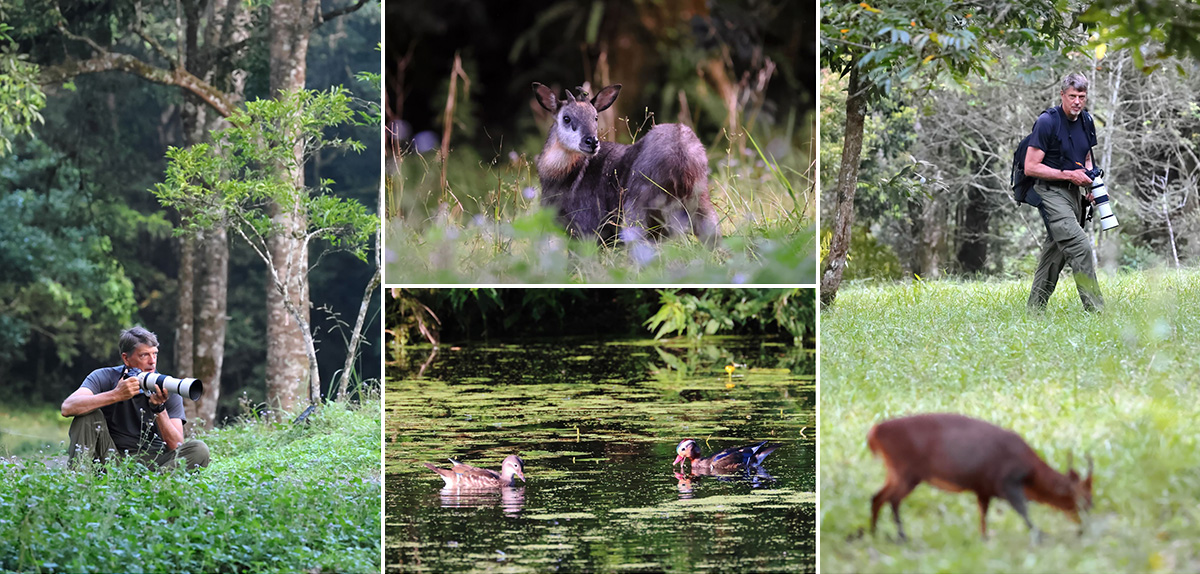
Thanks to strict regulations, the animals in Fushan Botanical Garden generally appear relaxed and at ease, allowing Tim to enjoy several fresh and memorable experiences.
Left: Tim patiently waits for a muntjac to move into the ideal position.
Top center: A Formosan serow in Fushan.
Bottom center: Mandarin ducks in the aquatic plant pond.
Right: Tim observes the a muntjac’s behavior, assessing its likely path to pre-select the best shooting angle.
As editor-in-chief Yongshih Lee noted, if readers hold a stereotypical view of National Geographic photographers—navigating dense jungles and facing life-or-death situations—“multiply that imagination by three, five, or even ten, and that’s Tim.” Since his debut piece, Borneo’s Wild Gliders, was featured in the inaugural issue of National Geographic’s Traditional Chinese edition in January 2001, Tim has become a leading figure in wildlife photography—akin to the Tom Cruise of the field. During the forum and subsequent events in Taiwan, he generously shared the immense effort behind each of his breathtaking images.
To photograph the Greater Bird of Paradise (Paradisaea apoda), which courts on bare branches above the canopy, Tim climbs dozens of meters to scout the best vantage points. After visualizing the ideal angles and composition, he builds a camouflage tent from vines and leaves, blending seamlessly into the treetops and waiting for days until the birds feel safe enough to perform their courtship displays. In Venezuela’s mangrove intertidal zone, while photographing Scarlet Ibises (Eudocimus ruber), Tim constructed a wooden platform on a large tire base, placed a camouflage tent on top, and added branches and leaves for extra concealment. He then pushed the platform through the mud to his chosen spot. After spending the night inside, waiting for the birds to arrive at dawn, he miscalculated the tide and awoke to find his platform submerged.
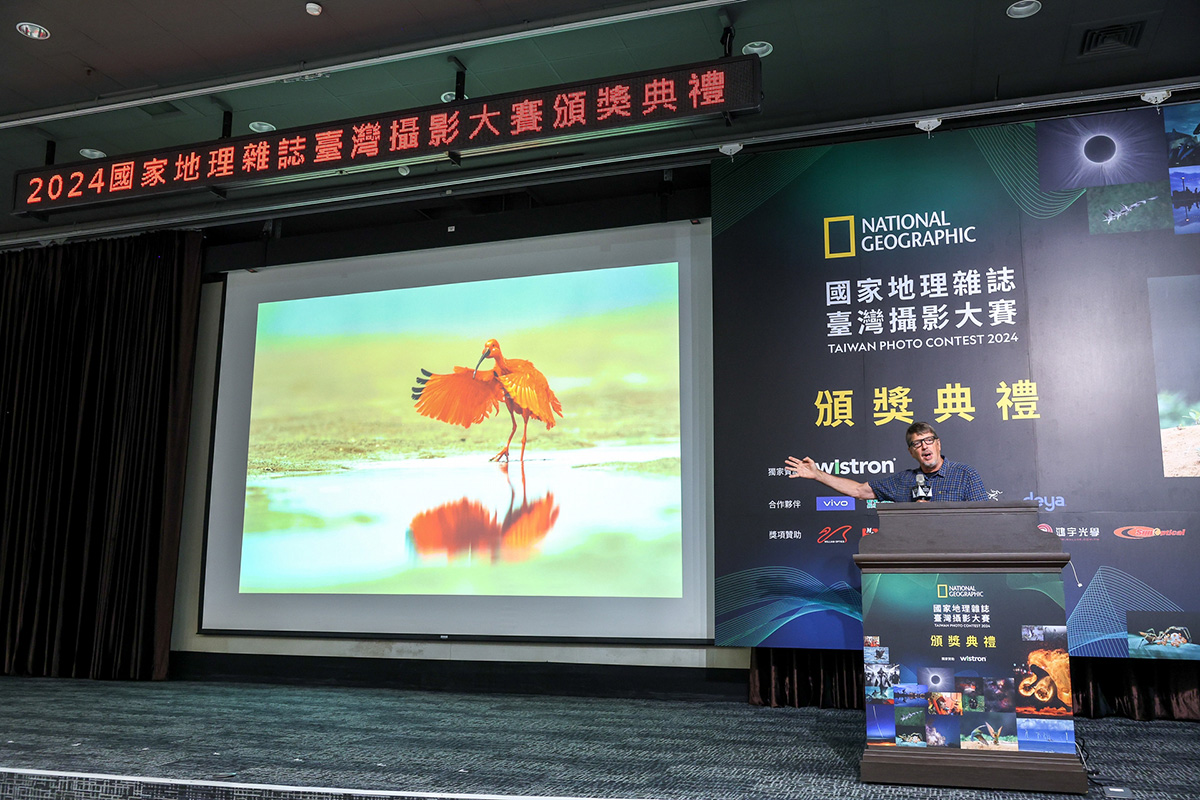
Tim shared with the audience both the most thrilling and the toughest, messiest moments from his decades-long photography career. Some environments were extreme and unforgiving, and every shot came with immense effort. (Photo courtesy of the organizer)
Perhaps the most inspiring moment came when, while tracking the Vogelkop Lophorina on the forest floor of Indonesia, Tim unexpectedly discovered that populations on two separate mountain ranges had evolved into two almost entirely distinct species—adding yet another bird-of-paradise to the world. What the audience saw in the lecture wasn’t just breathtaking images of birds, but also the story behind them: the dirt-covered, weary photographer wading through tidal flats, perched on branches dozens of meters above the ground, or pushing through dense, pathless jungle. It was a glimpse into the danger, determination, and devotion poured into each firsthand observation.
A Little Journey in Taiwan
Tim's last visit to Taiwan was 40 years ago, shortly after he graduated from university, and it was only a brief stopover. To help Tim experience Taiwan's natural beauty during his two-day trip, the National Geographic team, along with exclusive sponsor Wistron Corporation, Wistron Foundation and the Society of Wilderness, invited Dr. Hsu Yu-Cheng, a bird expert from National Dong Hwa University, to join him. They visited the Taiwan Forestry Research Institute's Fushan Research Center in Yilan and made a quick stop at Shuanglianpi Wetland of National Importance, which hosted the Nature Photography & Environmental Storytelling Workshop. During their visit, Tim exchanged ideas with workshop participants and met with partners from the Society of Wilderness, showcasing Taiwan’s grassroots and academic efforts in ecological conservation.
The Highest-Altitude Botanical Garden in Taiwan
Fushan Research Center is best known for its Botanical Garden, which limits the number of daily visitors and closes annually to allow plants and animals to recuperate. However, few people realize it also manages a water source protection area and the Hapen Nature Reserve. Making it a key site for forestry research and the youngest botanical garden under the Forestry Research Institute. Assistant Researcher Lin Chien-Jung explained to Tim that Fushan, situated at an elevation of 600 meters and influenced by the northeast monsoon, has a cool, humid climate, —ideal for the Institute’s Future Green Project, which focuses on preserving endangered plant species highly sensitive to environmental changes.
Chien-Jung emphasized that the Future Green Project's main goal is to integrate conservation efforts across Taiwan and identify the best locations for ex situ conservation. Fushan's greenhouse houses over 600 species of endangered plants, including Trapa incisa var. sieb, which relies on migratory birds for seed dispersal, and species like the dwarf ambulia (Limnophila sessiliflora) and humped bladderwort (Utricularia gibba), both once grew at Shuanglianpi.
Tim’s First-Time Moments
Though experienced in the field, Tim encountered several firsts at Fushan. At dusk, while discussing the area's unique environment and bird species with Dr. Hsu, he spotted a few mandarin ducks resting on the far side of the pond through his binoculars. Shaking his head, he remarked that he had never seen mandarin ducks in the wild before—only in captivity. Excited, he planned to return at dawn to capture images of the ducks swimming. "I checked—sunrise is at 5:30," he said, calmly demonstrating his proactive approach to this rare opportunity.
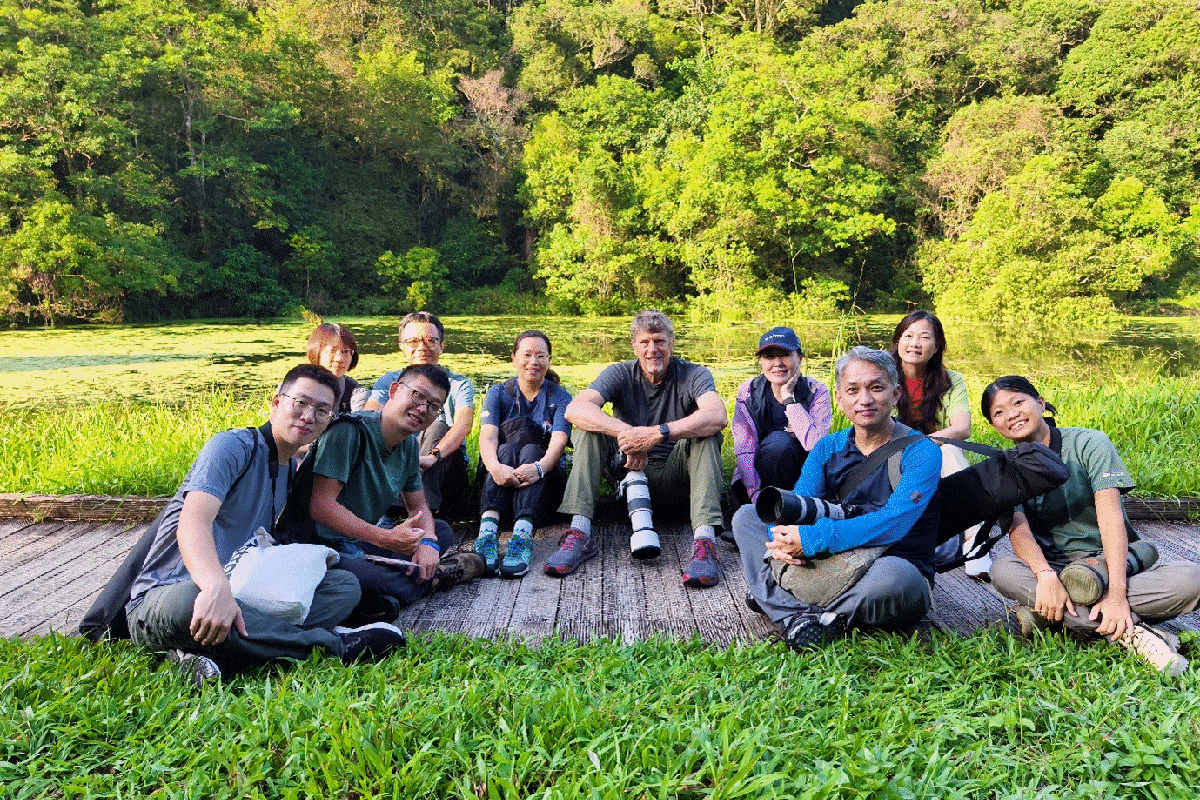
Travel companions at the Fushan aquatic plant pond, including members from the Society of Wilderness, the Wistron Foundation, and the National Geographic team. (Photo courtesy of the organizer)
Due to strict regulations, the mammals in Fushan Botanical Garden are famously indifferent to humans. Shortly after entering, the group spotted a muntjac grazing leisurely. Everyone stopped to observe, quietly pulling out their cameras, smartphones, and binoculars. Tim whispered that in his 30 years of wildlife photography, he had only once captured a muntjac on a camera trap and had never seen one so at ease. He skillfully predicted the muntjac's movements, silently positioning himself for the perfect shot, demonstrating his deep understanding of animal behavior. Tim was particularly fascinated to learn that Formosan macaques in Fushan interact with muntjacs, even grooming them. Knowing his wife, primatologist Cheryl Knott, would be intrigued, Tim likely left Fushan with an even greater impression after seeing footage of these interactions.
Shuanglianpi: Home to Taiwan’s Largest Floating Island
Another stop was Shuanglianpi, a lake located at an elevation of about 470 meters. Once home to one-third of Taiwan's aquatic plant species, the area experienced significant development over 20 years ago, resulting in the loss of many species. Eventually, the Yilan County government purchased the land from a private owner and designated it as a wildlife sanctuary and a Wetland of National Importance. The Society of Wilderness, which has monitored Shuanglianpi's development from the start, established a conservation base by the lake and continues to protect it to this day.
The most distinctive feature of Shuanglianpi is its four-hectare natural floating island—the largest of its kind in Taiwan. Formed over a long period by the intertwined roots and rhizomes of various aquatic plants, this dense mat of vegetation supports a rich diversity of flora and fauna, including large trees like Salix kusanoi. In the past, strong winds could occasionally shift the island's position, but today it is strictly regulated, and even research surveys require prior approval. Accompanied by Dr. Hsu, a member of the National Important Wetland Committee, Tim visited the floating island to explore the unique wetland ecology of Shuanglianpi.
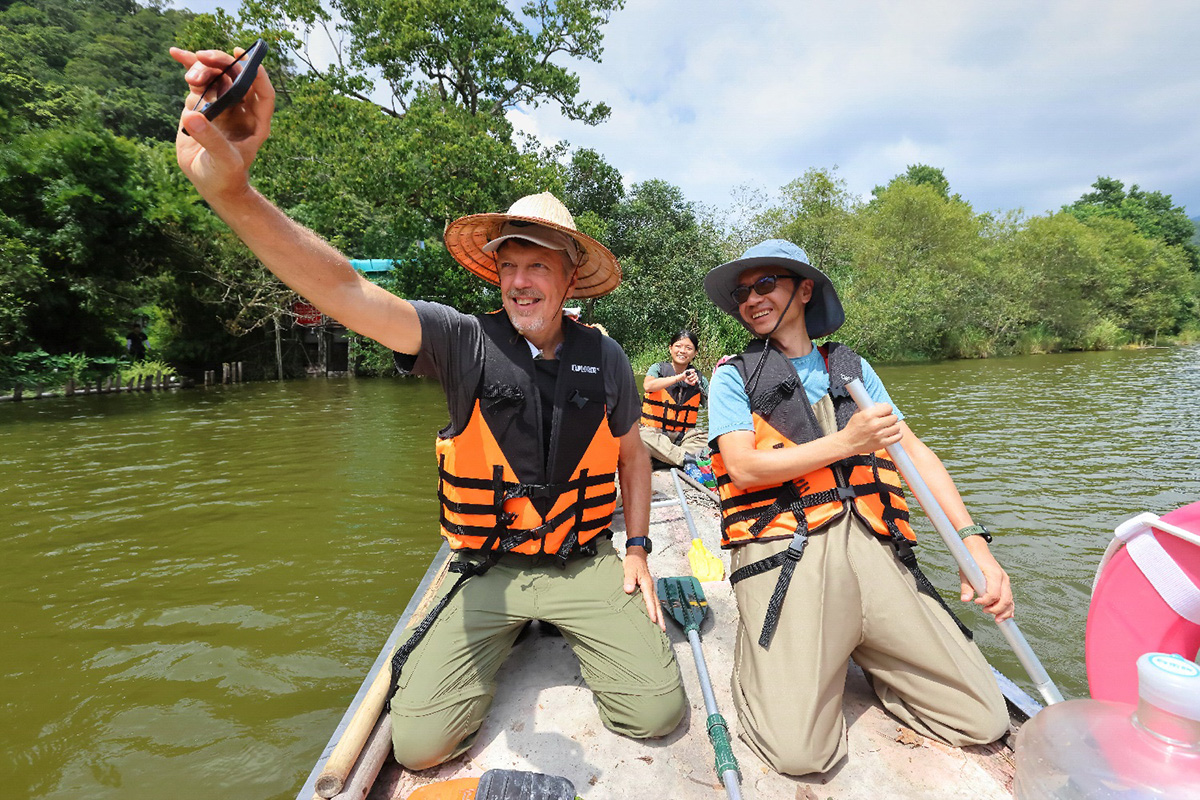
Tim, wearing a traditional bamboo hat, boards the “research boat” owned by the Yilan County Government to paddle toward the floating island on Shuanglianpi. On the right is Associate Professor Hsu Yu-Cheng from National Dong Hwa University.
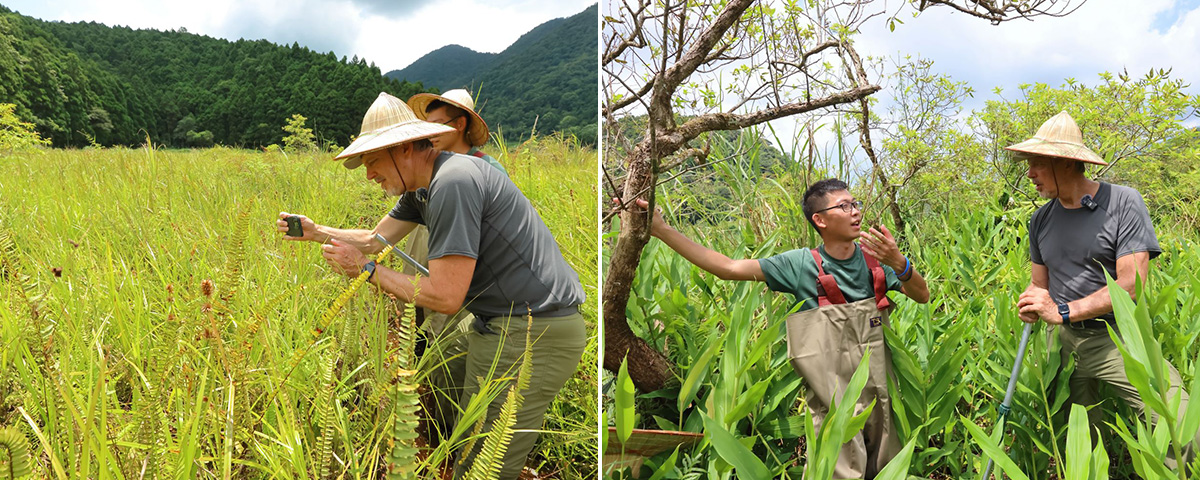
Left: The floating island is a thick mat formed by the intertwined stems, roots, and leaves of aquatic plants. Over time, other plants have taken root, creating a unique ecosystem. Tim takes out his phone to photograph the flower of the endangered Rhynchospora malasica.
Right: Hung-Yi Huang (left), a researcher from the Society of Wilderness, explains to Tim that ginger lily on the island can inhibit the growth of the endangered tree species Salix kusanoi.
Master's Remark
The National Geographic Storytelling Workshop was held at Shuanglianpi, with support from the Wistron Foundation and The Society of Wilderness. The workshop gave participants an in-depth understanding of this valuable wetland and its challenges. Tim’s presence provided a rare opportunity for attendees to present their work, and he offered insightful feedback on their compositions, angles, and use of color.
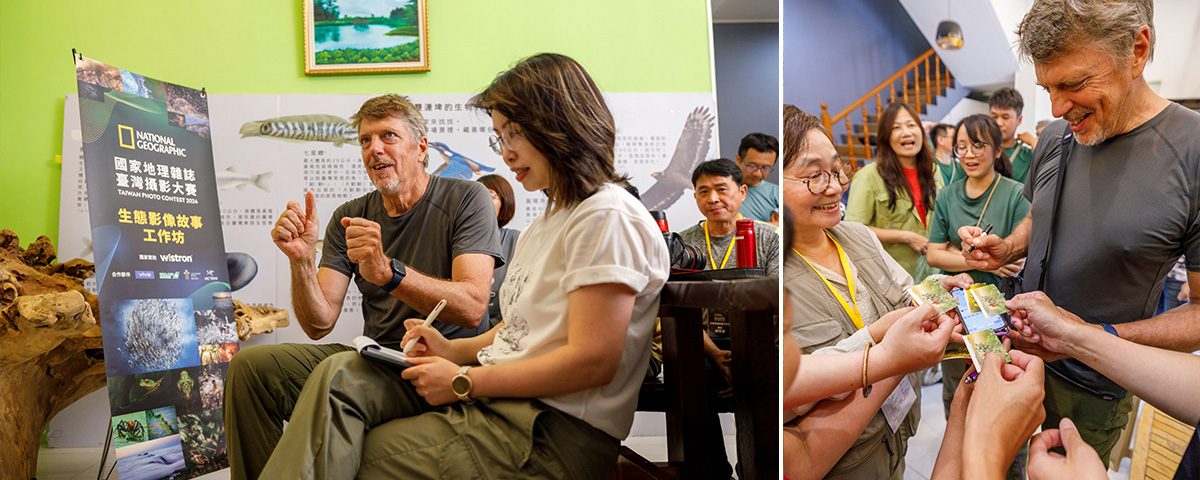
In the Nature Photography & Environmental Storytelling Workshop, Tim provided thoughtful and practical advice for each participant's work. Thanks to his visit, the participants had a rare opportunity to seek Tim’s opinion. (Photo courtesy of the organizer)
When discussing the challenges of wildlife photography, Tim emphasized the importance of first finding the right angle, height, and direction while visualizing the composition in advance—then it’s simply a matter of waiting. The key is predicting the animal's next move, which comes from years of observation. For example, birds show subtle signs before taking action. Whether they are about to fly, court, or fight, these preparatory movements help photographers anticipate the moment and capture the perfect shot.
Finally, one participant asked Tim, "How do you balance your passion for photography with real-life demands?" Tim responded that if there is a project you are truly passionate about, you should go for it. While he occasionally takes on cultural or documentary assignments for practical reasons, he always makes sure to set aside time for his personal projects.
Perhaps it is because of National Geographic's support, which enables photographers and adventurers like Tim to undertake challenging projects, bringing stories from distant places to readers worldwide and inspiring a new generation to follow in their footsteps. Tim was deeply moved to see his work inspire young people and to witness the passion for conservation from workshop participants and The Society of Wilderness. We, in turn, are grateful for Tim’s generous sharing of insights during the two-day event, offering invaluable perspectives to both the audience and participants.
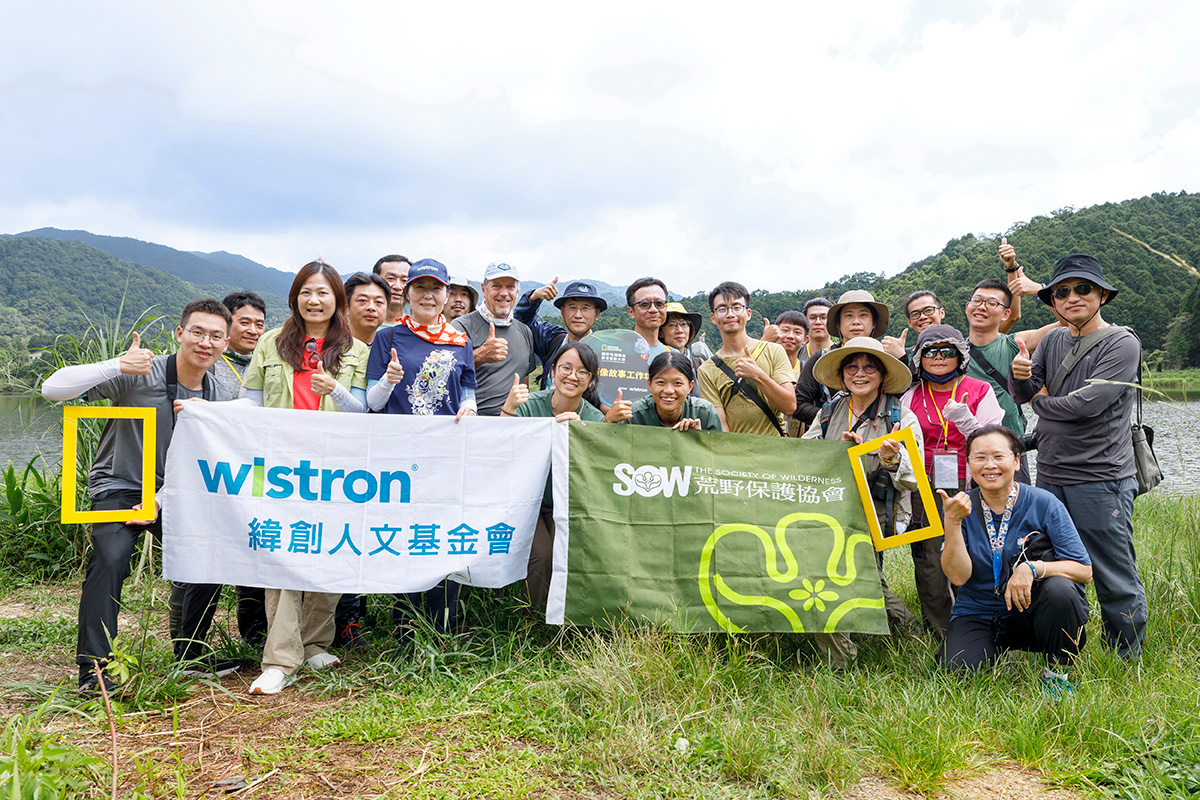
The Wistron Foundation, The Society of Wilderness, Associate Professor Hsu Yu-Cheng, the National Geographic team, and all the participants of the Nature Photography & Environmental Storytelling Workshop, together with Tim, at Shuanglianpi. (Photo courtesy of the organizer)
This article is authorized by National Geographic and also published on its official website. Written by Chung Hui-Yuan; Photography by Chen Yu-Wen.




 中
中